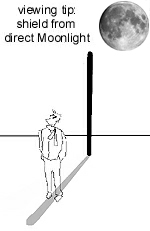|
Leonid MAC |
| home |
| View the shower |
| Mission Brief |
| Science Update |
| Media Brief |
| links |
What do you do when the Leonids
are gonna be spectacular, but it's a full Moon?
MOONING THE LEONIDS
"As the song goes: Look Away." Leonid storms night, 2002. It will be just about as full as a Moon can get without actually being completely full, which isn't the most fun. So what to do? First, plan to get out of town. The Moon light scatters badly on any form of dust and haze. There is plenty of it down town. Of course, we could all keep our car in the garage for a few days... If it looks like there will be low clouds (but not high), it will mean traveling to some clear sky location. Check the weather map to see where chances are best for clear weather. The higher the location you choose, the better chances that low dust and haze is not a problem. Viewing in the mountains should be great. WATCHING MOON IMPACTS If you have to do that, you'll probably end up with some time on your hands, and might even want to look at the Moon. Probably you'll be getting to your observing spot not earlier than 11 pm, when the Leonid radiant is rising above the horizon, since there's not much point in freezing all the way from sundown. However, don't miss out on those grazing fireballs from the first peak. If you are too late, you missed it. Best to arrive at 10:30, half an hour early. In that case, you will have some time before the storm happens. Go and look for Moon impacts! High power, focus on the Mares. Point your telescope. You do not want to completely blast out your dark adaption to the point where your eyes are too dazzled to see a long burner if you hear the beginning of the oohs and ahhhs... You're better off at high power, and you'd better have a Moon filter. I know, I'm no big fan of them, but this is one of the times when it would be handy. Best for such a situation is the standard old grey filter, usually sold (for example, by Orion) as a ... Moon Filter. The dual polarized adjustable whammy filters tend to have internal reflections and flaws that kind of mess up the view, in my opinion, and I don't like them. Make accurate notes of the precise time (seconds) of impact flashes and the location of the flash on the Moon's surface. Best to run you video or CCD camera system! WATCHING THE MOON THROUGH A TELESCOPE There is plenty of other things to see on the Moon as well. The full Moon is particularly good for observing rays (the bright radial lines coming from younger craters) and maria near the center of the disk. Maria are the darker areas, the remains of huge and ancient impacts that filled eventually with basalt, which is darker than the typical "highland" material. The contrast between the dark "seas" and light "highlands" is particularly sharp at full Moon. If the seeing is good, this will give you a chance to try some more detailed observing. The first thing to do will be to take a look at the western (left) side, where there should be a terminator still. Of particular interest will be the outer ring of Mare Orientale, the freshest of the huge impacts. The 'shock rings' are apparently a kind of resonance effect from such a huge impact, and if you've seen pictures of Orientale "from above" you know it looks like some weird dartboard or "bullseye." The libration toward us will be quite weak -- only a couple of degrees -- or this would be a pretty good night for observing Orientale. However, if you're up long enough, you should be able to glance now and then with any reasonable power and watch the light change. Also of interest will be Bailly in the south (a huge old crater) and probably Pythagoras in the north. The latter has a way of presenting itself as an "edge on" crater, where you can look across it and see the terraces of the far wall. It's hard to predict when the light will be exactly right for this to be really cool, but Leonid night offers an opportunity. There may be several lesser 'edge' craters too, so they might be fun. WATCHING THE LEONIDS IN A FULL MOON About now, you should be getting near 11 pm (and the Moon seemingly nearly overhead). At that point, you should pretty much be paying attention to large areas of the sky. The radiant has risen and you're moving into prime time. Are you on the east coast? Watch for grazing fireballs of the first storm peak. Are on the west coast: wait for the second storm peak to happen. You have to be out there at the right time! Check the expected timing here. The Moon is going to hamper the viewing. The dimmest meteors are washed out. But then, unlike other showers the Leonids are rich in the Big Bada Booms! Those should not be affected. So here are a couple of clues:
Compiled by: Dave North (north [at] znet.com) and Jane Houston Jones, AANC - Astronomical Association of Northern California, with tips from meteor astronomer Peter Jenniskens.
|

